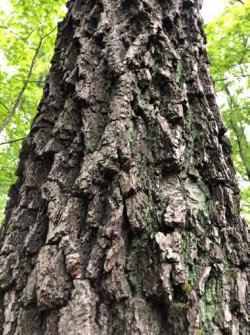AgEBB-MU CAFNR Extension
Green Horizons
Volume 25, Number 3
Fall 2021
 |
| This black hickory (Carya texana) stretches into the canopy at the Baskett Wildlife Research and Education Center in Ashland, MO |
The Other Hardwood: Hickories are not Oaks
Lauren Pile Knapp, Research Ecologist, US Forest Service
Hickories - the ever present, common, but rarely dominant genus of the oak-hickory forest. Although ecologically and economically important, the species in the hickory genera are often overshadowed in the popular and scientific literature by the oaks. Further, what we know about their biology and ecology and subsequently their management is often lumped with the oaks. This paradigm has led to the belief that if we manage for oaks, hickories will surely follow. But is this true?
Perhaps because we all have a bit of underdog in us, a group of us thought this under-appreciated member of the oak-hickory forest type deserved more attention. Most of what we know about the oak-hickory forests of today is that they are primarily derived from environmental conditions and disturbances that favor their establishment and growth over other species. Both oaks and hickories are favored with disturbance, such as fire, and are most competitive on sites that are warmer and drier making them likely candidates to do well in a warming climate.
However, the path that two genera take to reach the forest canopy is markedly different. Oaks (Quercus spp.) tend to respond to forest openings all at once, with most individuals occupying relatively similar heights and sizes, often being dominant or codominant in the forest canopy. Hickories (Carya spp.), on the other hand, take a slower approach to the race for the top, and this strategy starts at the earliest stage of the hickory's life, the seedling.
The seedlings of oaks and hickories are well-adapted to waiting out the tough times by investing more in roots than in stems and leaves. Like having a savings account for unexpected life events, investment in roots allows both oaks and hickories to readily regrow if top-killed by fire, browsing, or severe drought. This also allows them to persist in partial shade until there is a canopy opening. When a canopy opening occurs, they capitalize on their earlier investment by using the stored carbohydrates for stem and leaf growth and initiate rapid upward ascent to the canopy. Although oaks are well-known for this adaptive mechanism, hickories invest even more in their roots than oaks, allowing them to persist longer while waiting for a canopy opening. This conservative growth strategy can be seen in midstory hickories that are 140 years old.
As forest stands continue to mature and age, oaks perform best when they occupy the upper canopy of the forest, in dominant or codominant canopy positions. In more suppressed canopy positions, where light from above is limited, their greater shade tolerance allows hickories to fare well, growing more and dying less than the oaks. Although less abundant, over time a few hickories will find themselves among the oaks in the upper reaches of the canopy.
Why do we care if hickories, although broadly similar, are distinct from oaks? Oaks are incredibly important economically, and with the fall of the American chestnut, both oaks and hickories are unmatched in their production of hard mast for wildlife. With increasing stressors from land use change, climate warming, nonnative invasive pests, pathogens, and plants, promoting compositional and structural diversity in our forests will become even more critical. The more we understand 'every cog and wheel' the better it will aid our 'intelligent tinkering' needed for managing resilient forests for the future.
To learn more, visit: https://www.fs.usda.gov/treesearch/pubs/62769.
